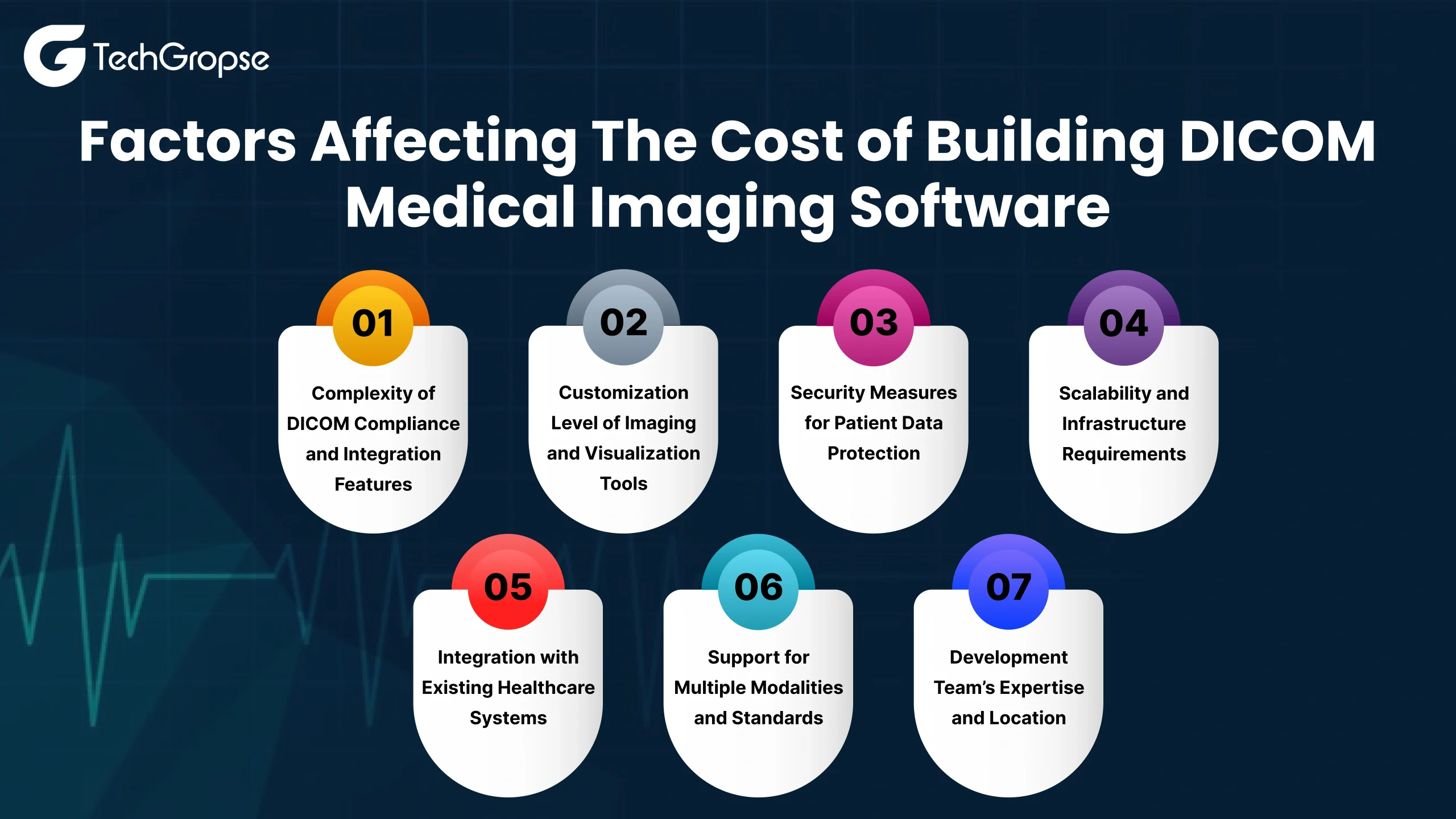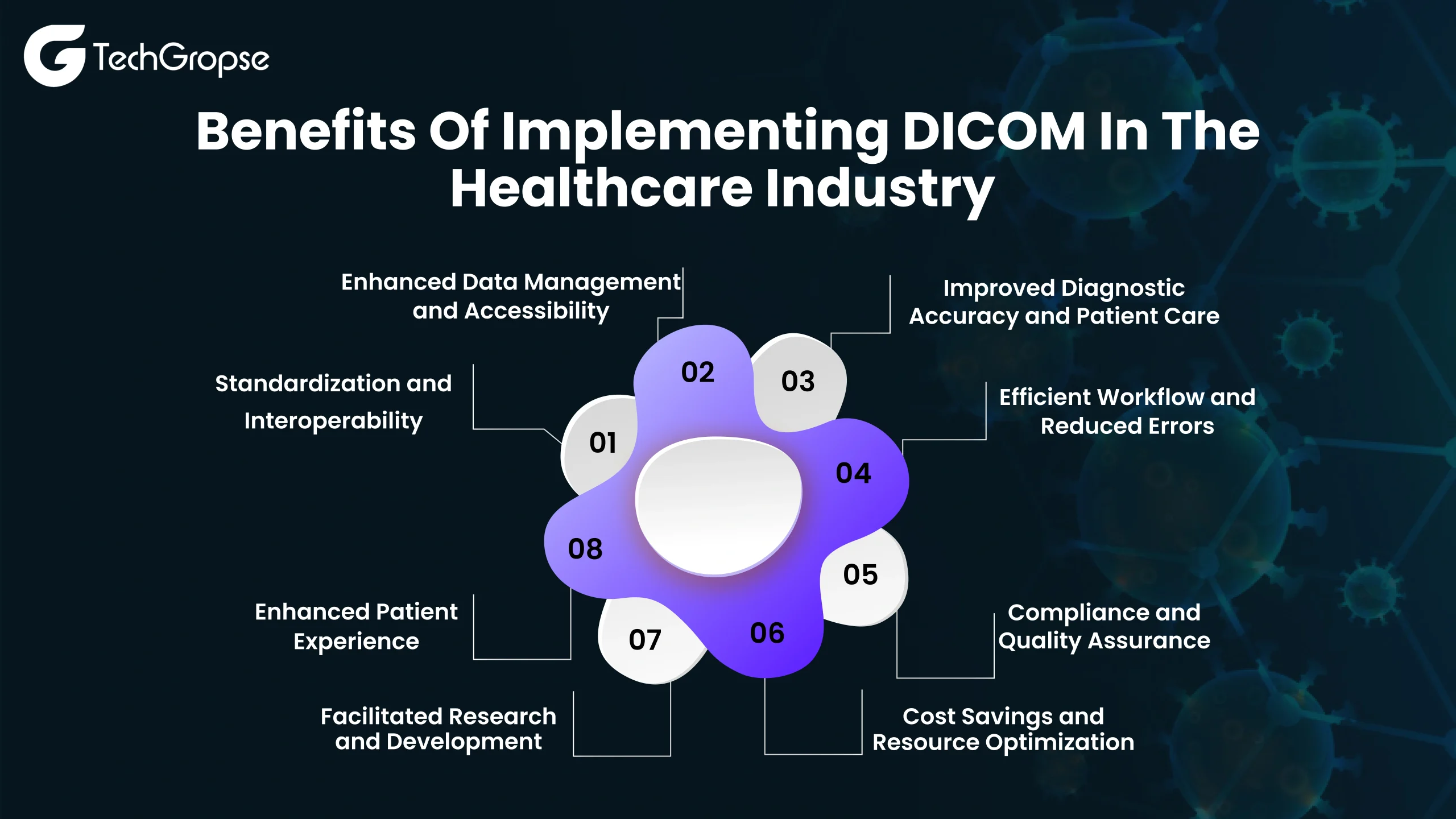We all know that the world is getting advanced with the latest technologies, and these innovations are crucial in the healthcare and medical industry. Imaging technologies, including DICOM medical imaging software, play a big role in today’s healthcare scene for diagnosis and treatment planning. Market forecasts show the field is growing fast, with its value set to jump from $7.52 billion in 2024 to $12.76 billion by 2030. Understanding the cost to build a DICOM medical imaging software is essential for stakeholders looking to invest in this rapidly evolving field.
Among the many imaging technologies and methods, Digital Imaging and Communications in Medicine (DICOM) has become the go-to format for storing, sending, and viewing medical images across different devices and platforms. When healthcare providers add DICOM medical imaging software to their toolkit, they see big gains in patient care more accurate diagnoses, and smoother workflows. As a result, more and more people want DICOM software development.
Building DICOM medical imaging software requires a thorough grasp of complex technical details and strict regulatory rules. It also calls for exceptional skill. The price to build DICOM medical imaging software can differ, from $30,000 to $300,000, depending on several factors.
This blog explores the subtle points about the Cost of building a DICOM medical imaging software and factors affecting the cost of building this app. We look into the different things that affect costs key features, and more. Our goal is to help healthcare groups make smart choices about their DICOM software investments.
Before we discuss the cost to build DICOM like standards, let’s learn the factors that affect the cost of building Digital Imaging and Communications in Medicine.
Factors Affecting The Cost of Building DICOM Medical Imaging Software
The cost to Build a DICOM Medical Imaging Software involves multiple stages and expertise. Here are the factors that significantly affect the cost of developing DICOM medical imaging software.

Complexity of DICOM Compliance and Integration Features
The primary requirement for integration with other medical imaging systems is compliance with the DICOM system protocol, which has highly specific rules for data representation and transmission over the network. Problems with the standards are that they are complex; hence they have a great impact on the healthcare app development process. To compel compliance, such features should be included to interact with the hospital information systems and electronic health records. This integration is not simple and calls for unique solutions that can meet the requirements of any particular institution and support data exchange.
Besides, the necessity of data security and privacy across different platforms further complicates requirements. Solutions that address this require extra time and capital to implement. The problem is that all these considerations are rather challenging yet it is possible to design DICOM software that will conform to the requirements and best practices of the industry.
Customization Level of Imaging and Visualization Tools
The level of specificity of the imaging and visualization capabilities affects– the cost of DICOM software development. Here, some of the functions of customization may lie in offering basic improvements to existing image-viewing capabilities, to the inclusion of sophisticated analysis tools for comprehensive analysis. These particular functions are intended to satisfy the detailed requirements of the health care workers making the software more useful and effective.
As already mentioned, with the degree of Customization there is also an increased level of difficulty. They do this because tools and functionalities increase in complexity; this results in longer development time and is costly. It is necessary to guarantee compliance with the common DICOM standard in the field of radiology as well as regulate the specifics of the requirements stated by the medical staff, which defines the general DICOM Software Development Cost.
Security Measures for Patient Data Protection
There is a need to incorporate tight security measures in DICOM medical imaging software to guard patients’ information. Since medical data is considered to be sensitive developers need to incorporate a high level of encryption, access control, and data integrity to meet the regulatory compliances and avoid data theft.
The need for development of these measures comes at a cost, the higher the level of sophistication the higher the cost. The challenge then remains on how to ensure the data is transmitted and stored with the highest security in place but at the same time remain open for access and fast use. Implementation of quality security functions is important in protecting the patients’ data and also in the development of medical imaging products.
Scalability and Infrastructure Requirements
Another factor that needs to be taken into consideration, in order to understand the cost of DICOM software development is scalability and infrastructure. grew SP has to be able to accommodate larger populations and increased data sets than are found in smaller specialized healthcare facilities. The scalability of architecture also means that the cost of providing enough capacity for growing software demand will not cost much.
Costs relating to the hardware also affect the development cost, for example, capacity and storage of the servers, solutions for data storage, and network. The load that the medical imaging data puts on the software should be easily manageable by the software. Incorporation of planning for growth and architecture is beneficial in managing for future use since it ensures the software does not need constant upgrades hence expensive.
Integration with Existing Healthcare Systems
DICOM in the healthcare industry guarantees interoperability with hospital information systems (HIS), electronic health records (EHR), and other clinical solutions. These include solo custom development, middleware solutions, and a relatively long integration testing process.
This is important for improving patient care and the efficiency of handling patients but as you can imagine, increases the overall developmental costs due to the need to integrate these systems with existing ones. As seen there is always a need to integrate these tasks to enhance clinical processes and overall healthcare provision.
Support for Multiple Modalities and Standards
It is critically important for a medical system to support a range of imaging modes and support different standards. The software used in a DICOM must compile images from all the modalities including CT, MRI, X-ray, and even ultrasounds. Also, compatibility with IoT devices that are integrating into healthcare is also becoming critical.
It is complex to integrate multiple modalities and couple that with keeping up with international healthcare standards which adds to the cost. There is also added value in supporting various kinds of imaging technologies and making sure that communication between the systems and devices is smooth, but it is also a very large investment in development.
Development Team’s Expertise and Location
The skills and location of the development team influence the cost when developing DICOM medical imaging software greatly. This is an area where highly skilled and experienced developers are paid more because of their proficiency in medical imaging and DICOM standards; and healthcare information technology.
But constructing a great team is not only about hiring developers, it is much more complex. It also needs project management, technical leadership, development operations, business analysis, user experience interface design, and QA engineering professionals to integrate to provide a balanced approach to development.
Let’s understand the first layer of cost to build a DICOM medical imaging software with the help of a table:
| Regions | Hourly Rate |
|---|---|
| UAE | $61-$66 |
| US | $94-$99 |
| Western Europe | $81-$91 |
| Australia | $72-$92 |
| Asia | $26-$42 |
Through those aspects, developers will be able to control and meet the standard and operational needs of the DICOM medical imaging software as well as cost control.
Benefits Of Implementing DICOM In The Healthcare Industry
Standardization and Interoperability
Unified Format: The DICOM application is primarily used to maintain the interoperability of medical images and other information in digital format that makes images of a certain modality resemble others like them irrespective of the type of equipment that produced them. This standardization is important to enable communication between different techniques of imaging like MRI, CT, and X-ray machines among others, and different systems in the healthcare industry.
Seamless Integration: As pointed out earlier, DICOM facilitates the sharing of information between various systems and application software in imaging. This integration enhances work processes as well as organizational relations between personnel in the healthcare system, which is independent of a technology or a vendor.
Enhanced Data Management and Accessibility
Central Image Storage: DICOM enables central storage of medical images and related data in a Picture Archiving and Communication System (PACS). This centralization helps to manage, retrieve, and share images, which boosts data access.
Access from Afar: Web-based apps and mobile platforms let healthcare providers view and diagnose DICOM images from different places. This flexibility proves useful for telemedicine and long-distance consults.
Improved Diagnostic Accuracy and Patient Care
Cutting-Edge Imaging: DICOM backs many imaging methods and formats, which results in detailed high-quality images. This ability helps healthcare providers make more accurate diagnoses by giving them clear exact visual info.
Better Ways to See Images: DICOM software comes with top-notch tools to analyze images. These include 3D rebuilding, merging pictures, and adding notes. These tools help doctors grasp and explain tricky health issues better. This leads to better care and treatment plans for patients.
Efficient Workflow and Reduced Errors
Hands-Off Processes: DICOM lets imaging tasks run on their own. This covers getting images working on them, and writing reports. When things run by themselves, it cuts down on typos from manual data entry. It also makes the whole process faster in medical imaging areas.
Smoother Talking: DICOM has a set way for everyone to share images and reports. This makes it easy for different hospital parts and health centers to swap info. When sharing gets easier, there’s less chance of mistakes. It also means patients don’t have to wait as long for care.
Compliance and Quality Assurance
Following the Rules: DICOM compliance makes sure medical imaging practices stick to industry rules and standards. This sticking to the rules is key to meet quality checks and keep accreditation from health bodies.
Same High Quality: By making imaging formats and methods the same, DICOM helps keep image quality the same across different machines and systems. This sameness is key for correct diagnoses and trustworthy patient records.
Cost Savings and Resource Optimization
Less Waste: DICOM’s central data handling cuts down the need to repeat imaging studies and stores less of the same data. This smarter way of doing things saves money in both data storage and imaging procedures.
Better Use of Resources: DICOM makes workflows smoother and automates processes, which helps imaging departments manage their resources better. This boost in productivity allows staff to use their time more and get more out of their imaging equipment.
Facilitated Research and Development
Sharing Data for Studies: Because DICOM uses a standard format, it’s easier for research centers to share imaging data with each other. This makes it simpler to work together on studies and push medical research forward.
Working with AI and Machine Learning: Data that works with DICOM can be used to teach AI and machine learning models. This leads to new ideas in automatic diagnosis and predicting outcomes. This teamwork with technology helps medical research and tech keep moving ahead.
Enhanced Patient Experience
Quicker Results: DICOM-based systems boost productivity in capturing, handling, and documenting images. This speedier process makes things better for patients and cuts down on waiting for test outcomes.
Easy Access and Handiness: Being able to open and share image data on different systems and in various places makes life easier for both doctors and patients. It helps care teams work together more and take action sooner when needed.
Must Read: How Generative AI in Healthcare is Revolutionizing the Industry
Features for Building Efficient DICOM Software
There are multiple benefits of implementing the DICOM medical software image format in your healthcare business. Some major of them are given below:
– DICOM image viewing and manipulation are critical for diagnosing and treating patients.
– Patient information management is a cornerstone of DICOM software, ensuring data is organized well.
– Secure image storage and archiving are vital for maintaining integrity.
– Multi-modality is essential for DICOM software to accommodate various types of medical imaging techniques.
– Image annotation and reporting tools are critical for enhancing diagnostic capabilities.
– EHR which stands for Electronic Health Records is important for comprehensive patient care.
– Advanced image processing algorithms enhance the capabilities of DICOM like software.
– Tele-radiology capabilities help radiologists to diagnose patients from remote locations.
– User access control and audit are critical for maintaining the security of medical data within DICOM software.
– Mobile access and web-based viewing are transforming healthcare professionalism with DICOM software.
So, these are the major benefits of implementing DICOM like software in your healthcare business.
TechGropse: The Ultimate IT Solution
TechGropse can be your best partner as we have the world’s best professionals so, you can have the best App Developers to build you the best DICOM like software and other kinds of mobile applications or web solutions. You will find that here the DICOM medical imaging software development cost is competitive so, you need not be worried about the cost. In addition to that, we have 10+ years of experience in providing IT solutions so, you can trust us easily.
Benefits of partnering with TechGropse
- 10+ years of experience
- 1k+ successful project deliveries
- 200+ technology experts
- 1+ years of free maintenance & support
- Deals with every industry
So, what are you waiting for? Get to know the cost of developing a DICOM medical imaging software by contacting us or visiting our site by filling out the form. And we don’t just provide regular mobile applications but we also provide AI-based mobile applications as well. In addition to that, we also offer digital web solutions to you so you can hire us for all kinds of digitalized solutions and we will also provide you the back support for 1 year.
Frequently Asked Questions
DICOM is an abbreviation for Digital Imaging and Communications in Medicine, which is the standardized format utilized for saving, sending, and observing medical images on a range of devices and platforms.
Developing DICOM medical imaging software usually costs between $30,000 and $300,000, contingent on various factors. The ultimate cost is determined by elements like intricacy, personalization, and the skill level of the development team.
Adhering to specific protocols for data representation and transmission is crucial for ensuring DICOM compliance due to its complexity. Guaranteeing that the software complies with these standards and connects with other medical systems may lead to longer development time and higher costs as specialized solutions and thorough testing are necessary.

Hello All,
Aman Mishra has years of experience in the IT industry. His passion for helping people in all aspects of mobile app development. Therefore, He write several blogs that help the readers to get the appropriate information about mobile app development trends, technology, and many other aspects.In addition to providing mobile app development services in USA, he also provides maintenance & support services for businesses of all sizes. He tried to solve all their readers’ queries and ensure that the given information would be helpful for them.












